Cycle News Staff | July 21, 2024
OSET started in 2004 when Ian Smith, the founder and CEO, created an electric trials bike with help from Mike Buchholz, a trials rider and retired engineer. The bike was made for Smith’s son, Oliver, who took his first ride on the bike when he was 3 years old. This proof-of-concept led to the creation of the company that became OSET UK Ltd., and the little bikes quickly became popular for kids to learn to ride for fun or compete in trials events. The bikes have continued to evolve, and the OSET 12.5R (for kids between 3 and 5 years old) and the 16.0R (aimed at kids between 5 and 7 years old) dominate at youth trials competition. The popularity of OSET led to Triumph Motorcycles buying the company in June of 2022.
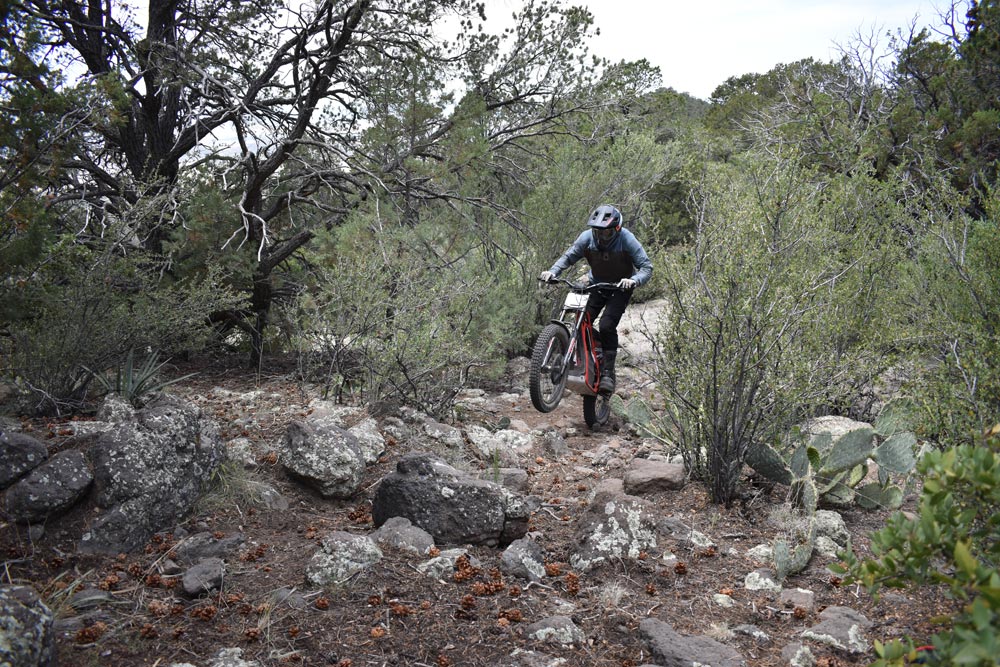
Photography by Scott Proffer, Trevor Nordin and Sean Finley
The brand continued to develop more models, including bikes aimed at teenagers and adults. The new TXP range, which hit the market in early 2024, is the latest evolution and includes the TXP-20 for 7- to 10-year-olds and the TXP-24 aimed at pre-teen and adult riders. The TXP-20 uses 15-inch front and 13-inch rear wheels, while the TXP-24 uses 19-inch front and 17-inch rear wheels. TXP stands for Trials Xplore Play, and they feature two seat options: a traditional trials “seat” and a more traditional motorcycle-type seat that makes it more versatile for those who want to use the bike for exploring trails. The completely new models include more power and torque, a new sealed lithium battery that provides a claimed four hours of runtime, a new chassis with adjustable air suspension and a fully adjustable speed/power/response control module. One of the most notable features is its total weight of just 108 pounds in trials setup and 112 pounds with the seat installed.
OSET sent us not one but two of the larger TXP-24 models for us to test. Why two? Because they said it is way more fun to have more than one to ride since they are so different from just about anything on the market. That proved to be exactly right. Having two allowed for several days of fun explorations around our neighborhood, and they are quiet enough to ride in the backyard without worrying about getting a phone call from your neighbor(s).
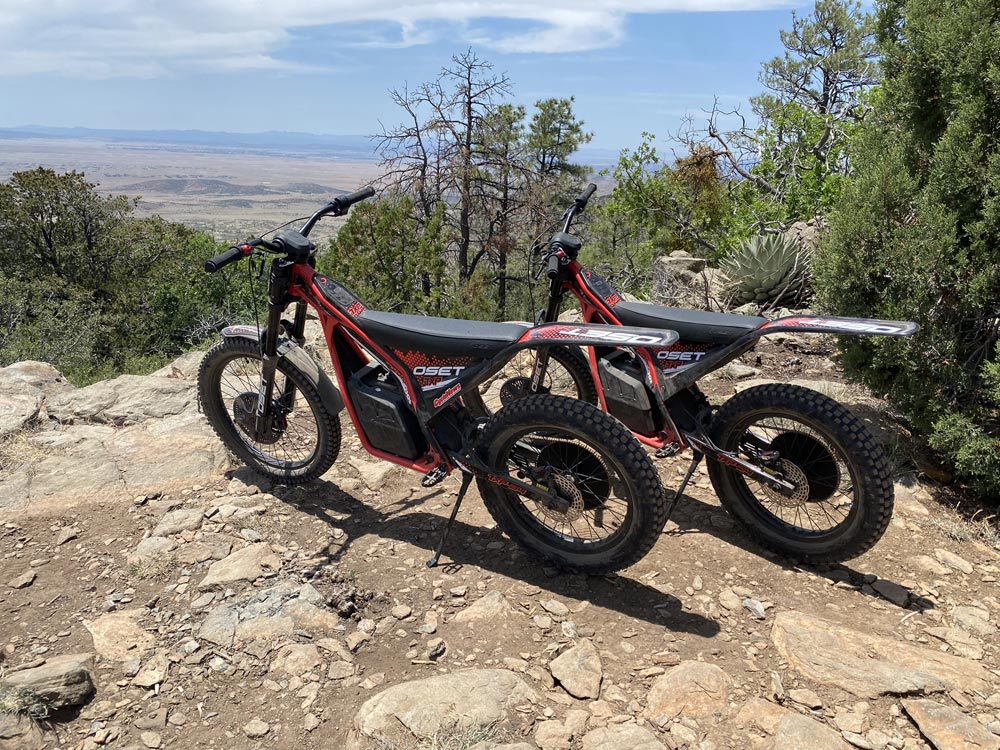 The OSET TXP-24 is aimed at pre-teen to adults up to 198 pounds. We found that new and experienced riders will have a blast on these bikes.
The OSET TXP-24 is aimed at pre-teen to adults up to 198 pounds. We found that new and experienced riders will have a blast on these bikes.
What’s In The Box? | 2024 OSET TXP-24 Review
We received the bikes in a crate, which allowed us to experience the build quality during the assembly process. They are well-designed with great attention to detail. The bikes, which are designed in the UK and manufactured in Taiwan, lean more toward downhill-mountain-bike components rather than full-size-motorcycle components. The air forks look very similar to downhill-mountain-bike components but feature a beefier axle and triple clamps. The assembly and setup instructions are very thorough and provide recommended air pressure and sag settings for the suspension.
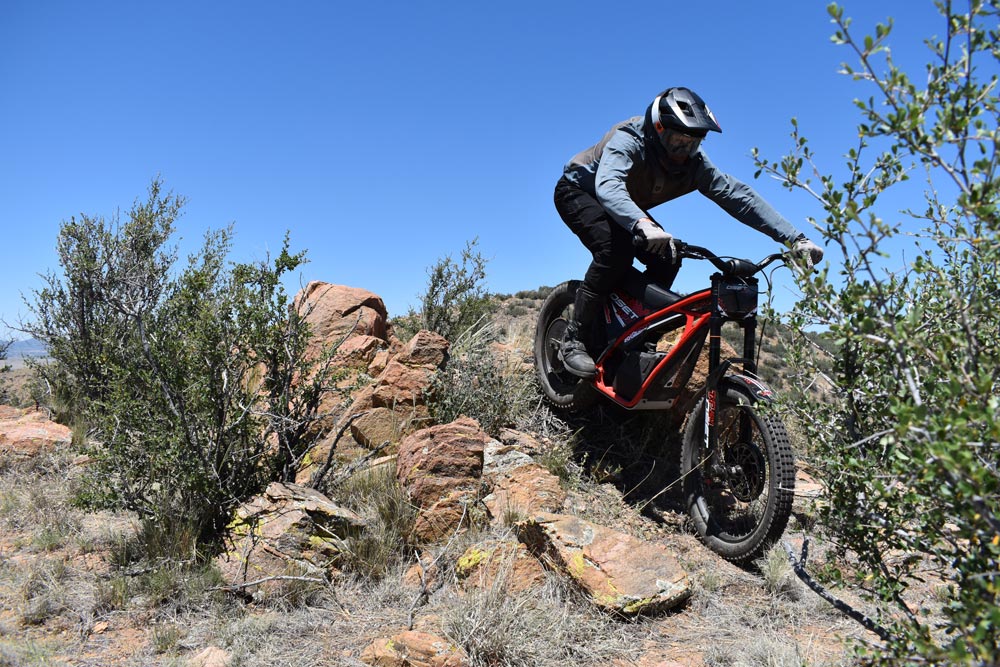 Trials bikes are great for improving your technique and the 108-pound OSET TXP-24 provides a great platform to practice skills.
Trials bikes are great for improving your technique and the 108-pound OSET TXP-24 provides a great platform to practice skills.
Trail-Friendly | 2024 OSET TXP-24 Review
Since all our test riders had more of an off-road riding rather than trials background, we chose to ride the bikes with the seats installed, and we were impressed with the versatility and predictability of the bikes. They completely differ from any gas or electric motorcycles we have ridden, including small-displacement trials bikes. They are so light and nimble that all our test riders were willing to push their limits on obstacles and hillclimbs, because you feel like you can step off and manhandle the bike if necessary.
The footpegs are placed further back than on a traditional trail bike but normal for a trials bike, so that takes a little time to get used to. The trade-off is the ability to weight the rear wheel for traction and easily pull wheelies. Despite the rear-biased footpeg placement, the front feels planted enough to provide confidence. Like other trials bikes, the OSET TXP is designed for standing up on the pegs to ride properly, and the seat is more for a rest when connecting trails or taking a break between riding sessions.
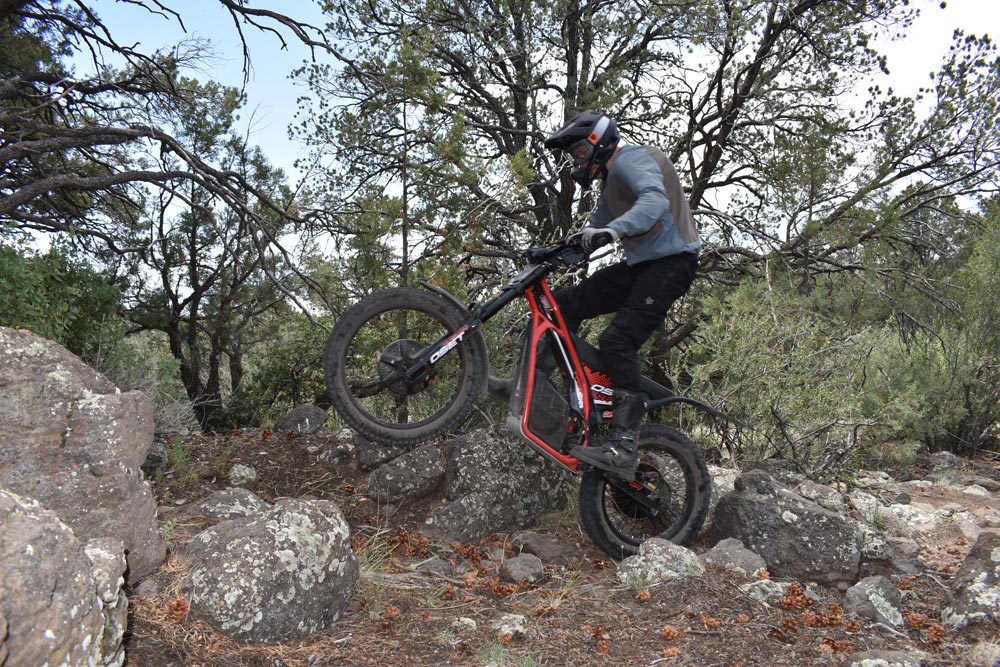 We took on some incredibly difficult trails on the OSET and found it easier to ride than a traditional motorcycle or even a traditional gas-powered trials bike for the hard stuff.
We took on some incredibly difficult trails on the OSET and found it easier to ride than a traditional motorcycle or even a traditional gas-powered trials bike for the hard stuff.
As is common on most electric motorcycles, the rear brake is hand-operated via a lever on the left side of the handlebars where the clutch lever would normally be on a gas-powered bike. For some people, that takes a little while to get used to, and some people find themselves looking for the rear brake with their right foot. But the tradeoff is that not using your feet to shift or apply the rear brake allows you to focus on weighting the footpegs for balance and traction. The brakes, with relatively small 7.87-inch front and 7.08-inch rear rotors, are powerful and predictable due to how lightweight the bike is.
As for power, the claimed 1600 watts provides plenty of power for an adult (max weight limit is 198 pounds) to have a lot of fun and climb steep and technical hills. Like most electric bikes, it has a lot of torque, which is great for slow technical riding like trials. It has a max speed of just 24 mph, which is slow if you are riding down an open road, but that is not what a trials bike is designed for. We took it on some trail loops but limited our time on the open roads and found it to be okay for those conditions. An integrated keypad allows you to change the settings for speed, power and throttle response (four levels of each), and that can be set up with a child lock to keep the settings from being changed. For experienced riders, we maxed out the speed and power settings but turned down the throttle response to make it easier to modulate the initial launch. The biggest adjustment for experienced riders is getting used to using the throttle without a clutch to control the traction and launch, but with a little time, you can find the sweet spot.
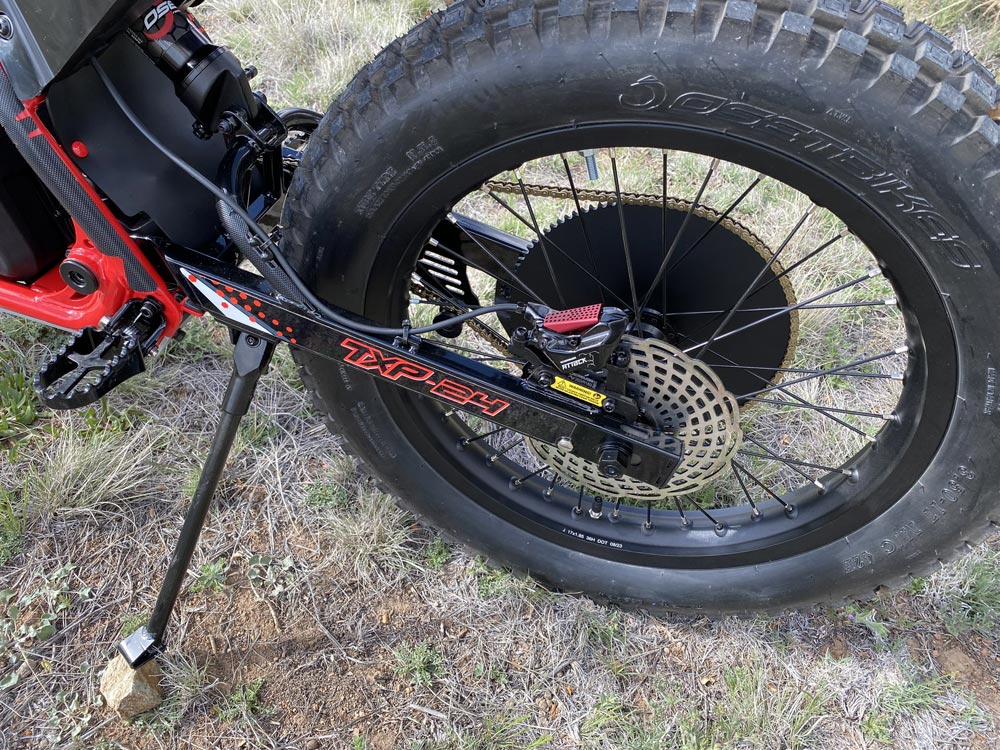 Although many of the components, including the brakes, are small by motorcycle standards, with a total weight of just 108 pounds, they provide plenty of performance.
Although many of the components, including the brakes, are small by motorcycle standards, with a total weight of just 108 pounds, they provide plenty of performance.
OSET claims that the TXP-24 has a four-hour run time for “normal riding” and we found that to be accurate. We did some rides that were up to two hours of actual riding time on extreme trails covering 16 miles and 2500 feet of elevation gain and still had some juice in the battery. It does take up to four hours to fully recharge the battery but unlike some electric bikes, we had plenty of riding time in by the time the battery was done for the day.
On some of those extreme trails, we found the max temperature limit of the drivetrain and had the warning tone and flashing light on the monitor that the bike was getting hot. If you keep pushing it, the bike will go into limp mode to keep from damaging the battery. This was not a problem when playing around on obstacles but long uphill climbing in warm conditions will hit the limit. These trails would have a gas-powered bike popping off steam from the radiators.
The OSET line is very versatile for different riding levels making them great for beginners. The simplicity of not needing to use your feet to shift or brake speeds up the learning process for new riders. And its light weight and low 25-inch seat height allows younger or shorter riders to touch the ground easily. The adjustable speed, power and throttle response settings allow you to tame the bike down to reduce the chances of new riders whisky throttling into the side of your truck.
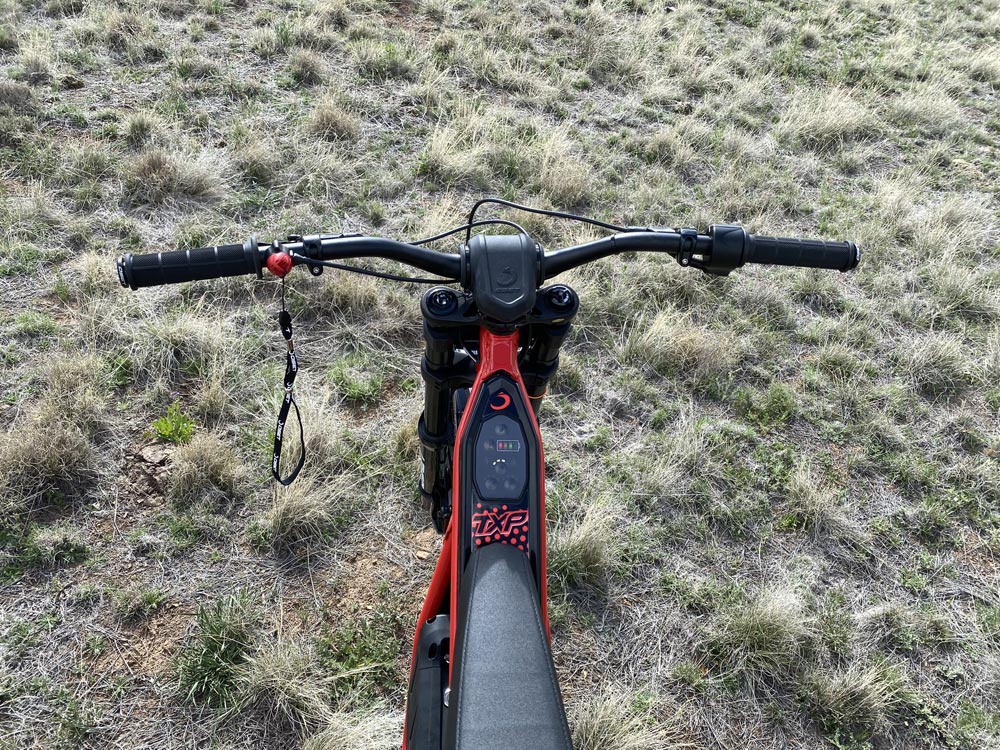 An integrated keypad allows you to adjust speed, power, and throttle response with four levels for each setting. It can also be set up with a child lock to prevent unauthorized changes.
An integrated keypad allows you to adjust speed, power, and throttle response with four levels for each setting. It can also be set up with a child lock to prevent unauthorized changes.
Experienced riders will find that trials bikes are great for improving your technical skills and give you the confidence to tackle more difficult obstacles, and that is true with the OSET TXP line. They are even lighter than gas-powered trials bikes and you can focus on the obstacles without worrying about being in the correct gear or using your feet for shifting and braking.
One of the trails that we took the TXP-24s up is extremely challenging with hard enduro-prepped 300 two-stroke off-road bikes, and we made it up easier than we could on those gas-powered bikes. Getting up those hills on the OSET helped improve our technique and confidence to return to the gas-powered bikes. Some will argue that an electric bike is not going to teach you clutch control and proper gear selection, so if that is important to you, then a gas-powered trials bike will be a better training tool, but you can learn a lot from the electric trials bike and being able to ride a quiet bike in your backyard is a big upside.
Speaking of upsides, the simplicity of the electric drive train and the lack of need for oil changes or clean air filters make it easier to own, especially for those with less mechanical experience. We put a lot of hours on the two bikes, and the only problems we experienced were the chain guards getting bent into the sprocket (but easily bent back out) and a leaking fork air seal on one of the two bikes.
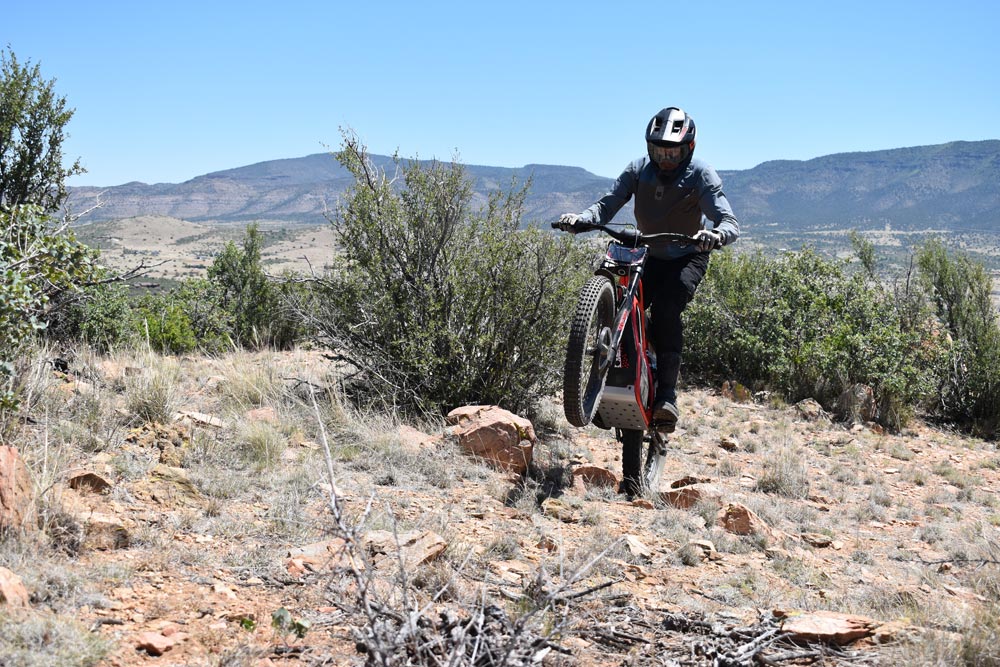 The battery provides a decent, approximately four-hour range so you can truly get away for a while.
The battery provides a decent, approximately four-hour range so you can truly get away for a while.
The Verdict | 2024 OSET TXP-24 Review
There is currently nothing like the OSET TXP Trials bikes on the market. The closest thing is the Electric Motion electric trials and trail bikes that are full-sized (21-inch front / 18-inch rear wheel sizes) and have more power and capabilities for serious riders, but those come with a price point over $10k, more than double the $4500 MSRP for the OSET TXP-24 model. The Surron Light Bee electric motorcycle (and several copycat versions of that) has a similar price point, but those are more of a traditional motorcycle design but also a lot of fun for new and experienced riders.
We had several people with varying degrees of riding ability ride the two OSET TXP-24s we had over a couple of months, and everybody had a blast on them. Less experienced riders found them easy to ride, but those who wanted to sit on the seat and ride around found the rearward footpeg placement and relatively short seat-to-footpeg placement felt a little awkward compared to other entry-level motorcycles. But that low seat height and adjustable power settings were great for recreational riders. The bikes are equally fun for experienced riders, and the ability to ride them in the backyard without making too much noise for your neighbors increases the riding opportunities. The lightweight and trials design is great for improving your technique or taking on more difficult obstacles, and with a $4500 price tag, it is not cheap but nearly half as much as many gas-powered trials bikes. So that makes it easier for a couple of buddies to get them and have a blast pushing the limits.CN
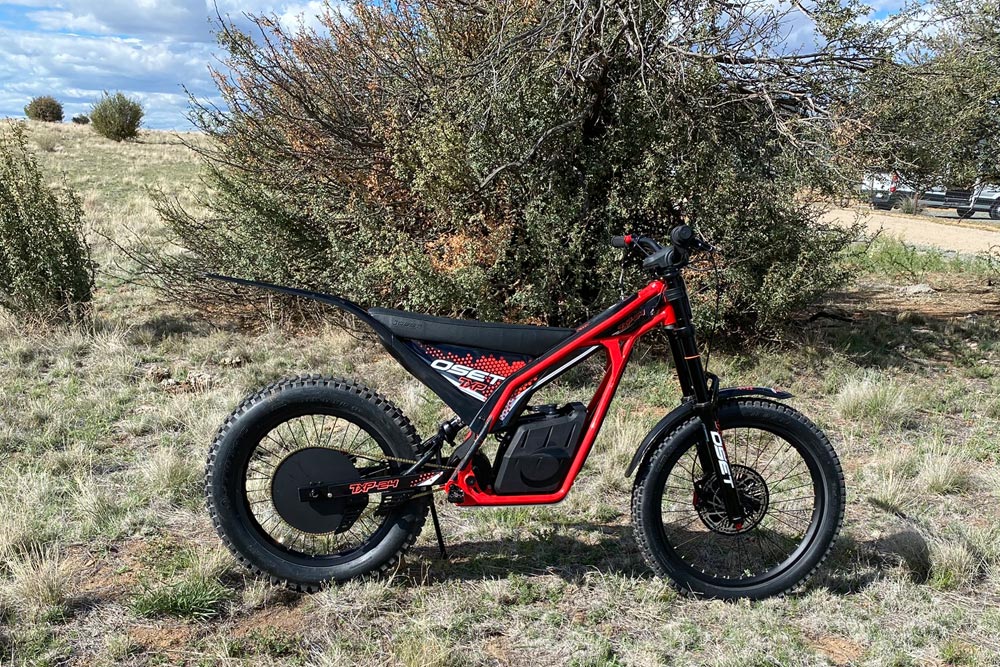
2024 OSET TXP-24 Specifications
| MSRP |
$4495 |
| Motor |
1600w OSET BLDC with position encoder |
| Frame |
Tubular steel, powder-coated, removable footpeg brackets and alloy sump plate |
| Swingarm |
Steel, with integrated chain tensioners and chain guide |
| Front suspension |
Triple crown air forks, rebound and volume adjustment |
| Rear suspension |
Air shock, rebound and volume adjustment |
| Front-wheel travel |
6.3 in. |
| Rear-wheel travel |
6.3 in. |
| Rims |
BC 19×1.60 36h (front), MC 17×1.85, 36h (rear) |
| Hubs |
4.3-in. x .79 in., Boost Alu, 36h (front), 5.9 in. x. 47 in. Alu, 36h, (rear). |
| Tires |
OSET Max Gripper, 19×2.75 in. (front), 17×3.50 in. (rear), trials pattern |
| Bike Weight |
Trials 108.2 lbs., Xplore 111.7 lbs. |
| Wheelbase |
48 in. |
| Ground clearance |
12 in. |
| Age range |
Pre-teen – adult |
| Seat height |
Trials 25 in.; Xplore 31.8 in. |
| Rider weight limit |
198.4 lbs. |
| Charger |
10 amp, Sensing/balancing |
| Batteries |
50.4v 28ah lithium, sealed with LED status indicator |
| Battery run time |
Up to 4 hours |
| Controller |
1600w brushless controller with IP66 connectors |
| Controller Settings |
4 x speed, 4x power, 4 x response |
| Handlebar |
30.7 in. width, 1.5 in. rise, 1.25 in. diameter, 7075 alloy |
| Handlebar height |
42.5 in. |
| Brakes |
4-piston hydraulic disc. 7.87 in. front/7.08 in. rear rotors |
| Footpegs |
OSET factory steel with replaceable hangers |
| Brake lever |
Competition-ready, rounded ball-end |
| Kill Switch |
OSET magnetic kill switch with lanyard |
| Throttle |
Dual sensing, twist type |
| Adjustment |
Integrated keypad, with speed, power and throttle response adjustment |
| Maximum speed |
24 mph |
